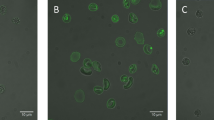Abstract
THE discocyte–spheroechinocyte transformation of red cells undergoing ATP depletion and calcium accumulation is reversible after restoration of normal ATP and calcium levels or exposure of cells to stomacytogenic agents such as cationic anaesthetics1–3. This transformation becomes irreversible after a prolonged incubation without glucose or an introduction of high calcium concentrations into the cells.4 In our studies of membrane protein composition of metabolically depleted red cells, we have noted that aerobically ATP-depleted erythrocytes contained a >1 × 106-dalton reducible membrane protein polymer which was selectively enriched in spectrin, the major protein at the cytosol membrane interface5. We suggested that the formation of this complex was due to changes in the assembly of spectrin in ATP-depleted red cell membranes to form closer contacts, allowing a spontaneous crosslinking of the nearest spectrin neighbours through disulphide couplings5. Another polymer differing from that in ATP-depleted red cells by an absence of cleavage with reducing agents was recently noted in fresh red cells, into which Ca2+ (>0.5 mM) was introduced by ionophore A23187 (ref. 6); it has been attributed to a crosslinking of γ-glutamyl ε-lysine residues of spectrin and other membrane proteins, catalysed by a Ca2+-activated cytoplasmic transglutaminase6,7. As both the above membrane protein polymers were found in cells which transformed into spheroechinocytic shape, we have studied and report here results which show that such spontaneous membrane protein crosslinking contributes to a permanent fixing of the red cells to their abnormal shape.
This is a preview of subscription content, access via your institution
Access options
Subscribe to this journal
Receive 51 print issues and online access
$199.00 per year
only $3.90 per issue
Buy this article
- Purchase on Springer Link
- Instant access to full article PDF
Prices may be subject to local taxes which are calculated during checkout
Similar content being viewed by others
References
Weed, R. I., LaCelle, P. L. & Merrill, E. W. J. clin. Invest. 48, 795–809 (1969).
Nakao, M., Nakao, T., Yamazoe, S. & Yoshikawa, H. J. Biochemistry 45, 487 (1961).
Palek, J. et al. Blood 50, 155–163 (1977).
White, J. G. Am. J. Path. 77, 507–514 (1974).
Palek, J., Liu, S. C. & Snyder, L. M. Blood 51, 385–395 (1978).
Lorand, L. & Weissmann, L. B. Proc. natn. Acad. Sci. U.S.A. 73, 4479–4481 (1976).
Anderson, D. R., Davis, J. L. & Carraway, K. L. J. biol. Chem. 252, 6617–6623 (1977).
Bessis, M. Nouv. Revue fr. Hémat. 12, 1–25 (1972).
Beutler, E. Red Cell Metabolism: A Manual of Biochemical Methods 2nd edn (Grune and Stratton, New York, 1975).
Liu, S. C., Fairbanks, G. & Palek, J. Biochemistry 16, 4066–4074 (1977).
Fortier, N. L., Snyder, L. M., Palek, J. & Weiss, E. B. J. Lab. clin. Med. 89, 41–50 (1977).
Palek, J., Church, A. & Fairbanks, G. Membranes and Diseases (eds Bolis, L., Hoffman, J. F. & Leaf, A.) 41–60 (Raven, New York, 1976).
Author information
Authors and Affiliations
Rights and permissions
About this article
Cite this article
PALEK, J., LIU, P. & LIU, S. Polymerisation of red cell membrane protein contributes to spheroechinocyte shape irreversibility. Nature 274, 505–507 (1978). https://doi.org/10.1038/274505a0
Received:
Accepted:
Issue Date:
DOI: https://doi.org/10.1038/274505a0
This article is cited by
-
Topo-optical investigations of the human erythrocyte glycocalyx-age related changes
Histochemistry (1984)
-
Erythrocyte membrane sidedness in lectin control of the Ca2+–A23187-mediated diskocyte ⇄ echinocyte conversion
Nature (1981)
-
Chloride permeability in human red cells: Influence of membrane protein rearrangement resulting from ATP depletion and calcium accumulation
The Journal of Membrane Biology (1981)
-
Effects of the calcium-mediated enzymatic cross-linking of membrane proteins on cellular deformability
The Journal of Membrane Biology (1981)
-
Duchenne muscular dystrophy
Human Genetics (1980)
Comments
By submitting a comment you agree to abide by our Terms and Community Guidelines. If you find something abusive or that does not comply with our terms or guidelines please flag it as inappropriate.



